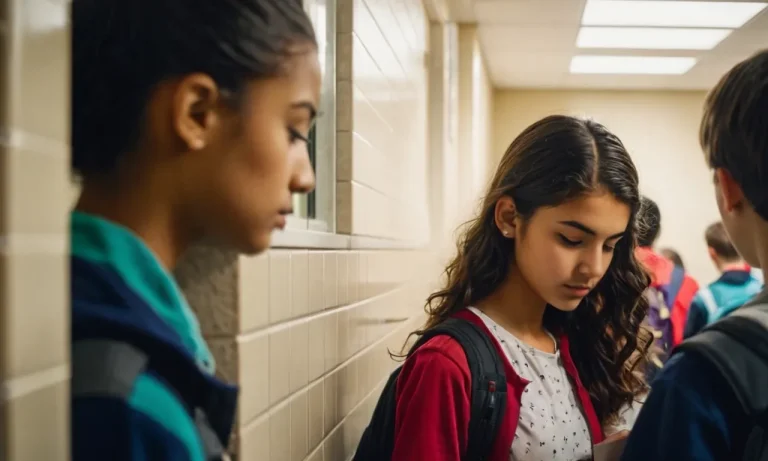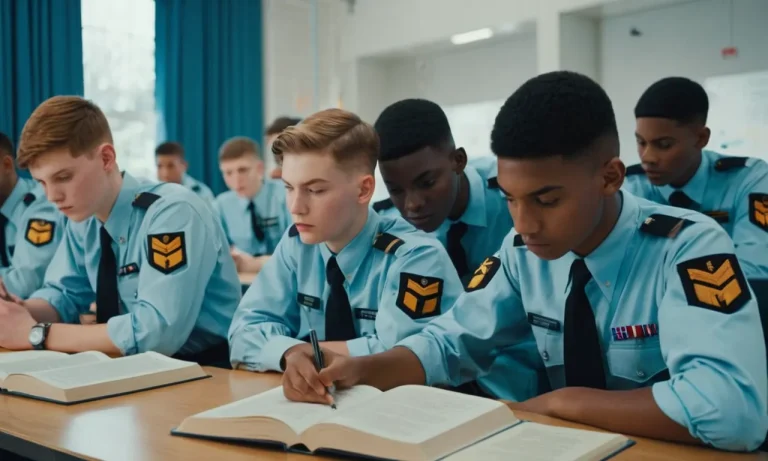Navigating the complex world of public school enrollment can be a daunting task for parents and guardians. With varying policies and regulations, the question of whether a public school can refuse to enroll a student often arises, leaving many families uncertain about their rights and options.
If you’re short on time, here’s a quick answer to your question: Public schools generally cannot refuse to enroll a student based on factors such as race, religion, or disability. However, there are certain circumstances where enrollment may be denied or delayed, such as residency requirements, disciplinary issues, or capacity constraints.
In this comprehensive article, we will delve into the intricacies of public school enrollment policies, exploring the legal framework, exceptions, and practical considerations. From understanding residency requirements to addressing disciplinary concerns, we’ll provide you with the knowledge you need to navigate this process successfully.
Legal Framework: Understanding the Rights of Students
Enrolling a child in a public school is a fundamental right in the United States, as education is considered a crucial component of a child’s development and future success. However, this right is not without limitations, and public schools must navigate a complex legal framework to ensure fair and equitable access to education for all students.
Federal and State Laws Governing Public School Enrollment
The primary federal law governing public school enrollment is the Equal Educational Opportunities Act of 1974. This law prohibits discrimination based on race, color, or national origin in public schools and educational programs that receive federal funding.
Additionally, the Individuals with Disabilities Education Act (IDEA) and Section 504 of the Rehabilitation Act of 1973 protect the rights of students with disabilities to receive a free and appropriate public education.
At the state level, each state has its own set of laws and regulations governing public school enrollment. These laws typically outline the residency requirements, age requirements, and documentation needed for enrollment.
For example, in California, the Residency Requirements state that a student must reside within the school district boundaries to be eligible for enrollment.
Non-Discrimination Policies and Protected Classes
Public schools are required to have non-discrimination policies in place to protect students from discrimination based on various protected classes. These protected classes may include race, color, national origin, religion, sex, disability, age, and more.
The Office for Civil Rights (OCR) within the U.S. Department of Education is responsible for enforcing federal civil rights laws that prohibit discrimination in educational programs and activities that receive federal funding.
It’s important to note that public schools cannot refuse to enroll a student based on their protected class or other discriminatory factors. However, there are some exceptions and limitations to this rule, which we will explore in the next section.
Exceptions and Limitations to Enrollment Rights
While public schools generally cannot refuse to enroll a student based on discriminatory factors, there are certain exceptions and limitations to this rule. For example, public schools may have enrollment caps or limits based on available resources and capacity.
In such cases, the school may use a fair and impartial lottery system or other non-discriminatory criteria to determine enrollment.
Additionally, public schools may have specific academic or behavioral requirements for enrollment in specialized programs or schools, such as magnet schools or gifted and talented programs. However, these requirements must be applied equally to all students and cannot discriminate against protected classes.
It’s crucial for parents and guardians to understand their rights and the legal framework surrounding public school enrollment. If you believe your child has been denied enrollment or discriminated against based on their protected class, you can file a complaint with the OCR or seek legal assistance.
Residency Requirements: Establishing Eligibility
When it comes to enrolling in a public school, one of the key criteria is establishing residency within the district. Residency requirements are in place to ensure that limited educational resources are allocated fairly and that students attend schools in the communities where their families live and pay taxes.
But how exactly is residency defined, and what documentation is required? Let’s dive in! 👩🏫
Defining Residency for Public School Enrollment
The definition of residency can vary slightly from district to district, but generally, it refers to the physical location where a student and their parent or legal guardian reside on a permanent basis.
This means having a fixed, regular, and adequate nighttime residence within the school district boundaries. Temporary living situations, such as staying with friends or relatives, may not qualify as establishing residency. According to the U.S.
Department of Education, residency is typically determined by factors like where the student sleeps at night, where their personal belongings are kept, and where they receive mail.
Proof of Residency Documentation
To verify residency, most school districts require families to provide specific documentation. Common examples include:
- A current utility bill (e.g., gas, electric, water) showing the parent/guardian’s name and address within the district
- A signed lease agreement or mortgage statement
- A property tax bill or receipt
- A valid driver’s license or state-issued ID with the current address
It’s important to note that the specific documentation requirements can vary, so it’s always best to check with your local school district for their specific policies.
Addressing Homelessness and Temporary Living Situations
While residency requirements are in place, the McKinney-Vento Homeless Assistance Act ensures that homeless children and youth have equal access to public education. Under this federal law, students experiencing homelessness or temporary living situations (such as staying in shelters, motels, or with friends/relatives due to loss of housing) must be immediately enrolled, even if they lack typical residency documentation.
Schools are required to assist these families in obtaining the necessary paperwork or provide alternative means of establishing eligibility. According to a recent study by the National Center for Homeless Education, approximately 1.5 million students experienced homelessness during the 2017-2018 school year, highlighting the importance of this act in ensuring educational access for all.
Navigating residency requirements can be a complex process, but by understanding the guidelines and being prepared with the necessary documentation, families can ensure a smoother enrollment experience.
And for those facing housing insecurity, the McKinney-Vento Act provides a crucial safety net to keep students in school and on track academically. With patience and understanding on both sides, public schools can uphold their commitment to serving the educational needs of their communities. 😊
Disciplinary Issues and Student Transfers
Expulsions and Suspensions from Previous Schools
Public schools have the right to refuse enrollment to students who have been expelled or suspended from their previous schools, especially if the disciplinary issues involved serious offenses such as violence, possession of weapons or drugs, or threats to the safety of others.
However, this decision must be made on a case-by-case basis, considering the specific circumstances and the student’s potential for rehabilitation. According to a study by the Education Commission of the States, around 20% of student expulsions nationwide are related to zero-tolerance policies for specific offenses.
😕
Schools must follow due process procedures and provide the student and their family with an opportunity to appeal the decision. The appeals process may involve hearings, reviews of evidence, and consideration of mitigating factors.
The goal is to strike a balance between maintaining a safe learning environment and providing educational opportunities for students who have made mistakes but are willing to take responsibility and demonstrate a commitment to positive behavior. 👏
Transferring Students with Disciplinary Records
When a student with a disciplinary record transfers to a new public school, the receiving school has the right to review the student’s records and make an informed decision about enrollment. This decision should be based on the severity of the offense(s), the student’s age, and the potential impact on the school community.
According to a report by the U.S. Department of Education, approximately 10% of student transfers involve students with disciplinary records. 📊
The school may choose to enroll the student with certain conditions or restrictions, such as a behavior contract, probationary period, or assignment to an alternative educational program. In some cases, the school may deny enrollment if the student’s disciplinary history poses a significant risk to the safety and well-being of other students and staff.
However, the decision must be made in a fair and impartial manner, without discrimination based on race, gender, disability, or other protected characteristics. 😊
Due Process Rights and Appeals
When a public school denies enrollment or imposes disciplinary sanctions on a student, the student and their family have the right to due process, which includes the opportunity to appeal the decision.
The appeals process typically involves a hearing where the student and their representatives can present evidence, witnesses, and arguments in their defense. It is crucial that schools follow established procedures and provide adequate notice and documentation to ensure fairness and transparency.
If the initial appeal is unsuccessful, the student may have the option to pursue further appeals at higher administrative levels or seek legal recourse through the court system. The appeals process aims to strike a balance between the school’s responsibility to maintain a safe and conducive learning environment and the student’s right to an education.
Ultimately, the goal is to find a resolution that serves the best interests of the student while upholding the integrity and safety of the educational community. 👍
Capacity Constraints and Enrollment Lotteries
Public schools often face the challenge of overcrowding due to limited resources and an increasing student population. This can lead to capacity constraints, where schools are unable to accommodate all students seeking enrollment.
To address this issue, many districts have implemented enrollment lotteries and waitlists. Let’s delve into this topic and explore the alternatives available for families.
Overcrowding and Limited Resources in Public Schools
Overcrowding in public schools is a significant concern, particularly in densely populated areas or regions experiencing rapid growth. When the number of students exceeds the school’s capacity, it can strain resources, lead to larger class sizes, and potentially compromise the quality of education.
According to a report by the National Education Association, 😔 overcrowded schools can negatively impact student achievement, teacher effectiveness, and overall school climate.
Enrollment Lotteries and Waitlists
To manage enrollment and ensure fair access, many public school districts have implemented enrollment lotteries and waitlists. This system is particularly common in areas with high demand for certain schools or programs.
🎉 When the number of applicants exceeds the available spots, a random lottery is conducted to determine which students will be offered enrollment. Those who are not selected are placed on a waitlist, and vacancies are filled as they become available.
The lottery process aims to provide an equitable chance for all students, regardless of factors like race, socioeconomic status, or academic performance. However, it can also lead to frustration for families who are not initially granted their preferred school choice.
The Education Week highlights some concerns around the fairness and transparency of these lotteries. 🤔
Alternative Options: Charter Schools and Open Enrollment
Families facing capacity constraints or enrollment lottery challenges in their local public schools may consider alternative options, such as charter schools or open enrollment programs. 👍
- Charter schools are publicly funded but independently operated, often with a specific educational focus or approach. They can provide an alternative option for families seeking a different learning environment or specialized curriculum.
- Open enrollment programs allow students to attend public schools outside their designated attendance zone, provided there is available capacity. This can offer families more choices and potentially alleviate overcrowding in certain areas.
However, it’s important to note that these alternatives may have their own admission criteria, waitlists, or limitations. Researching and understanding the options available in your area is crucial for making informed decisions about your child’s education. 😊
Conclusion
Navigating the complexities of public school enrollment can be a challenging process, but understanding your rights and the legal framework is crucial. While public schools generally cannot refuse enrollment based on factors such as race, religion, or disability, there are certain exceptions and limitations that parents and guardians should be aware of.
By familiarizing yourself with residency requirements, disciplinary policies, and capacity constraints, you can better advocate for your child’s educational needs and ensure a smooth enrollment process.
Remember, open communication with school administrators and a willingness to explore alternative options can often resolve enrollment challenges.
Ultimately, ensuring equal access to quality education is a shared responsibility between families, schools, and communities. By working together and staying informed, we can create an inclusive and supportive learning environment for all students.






